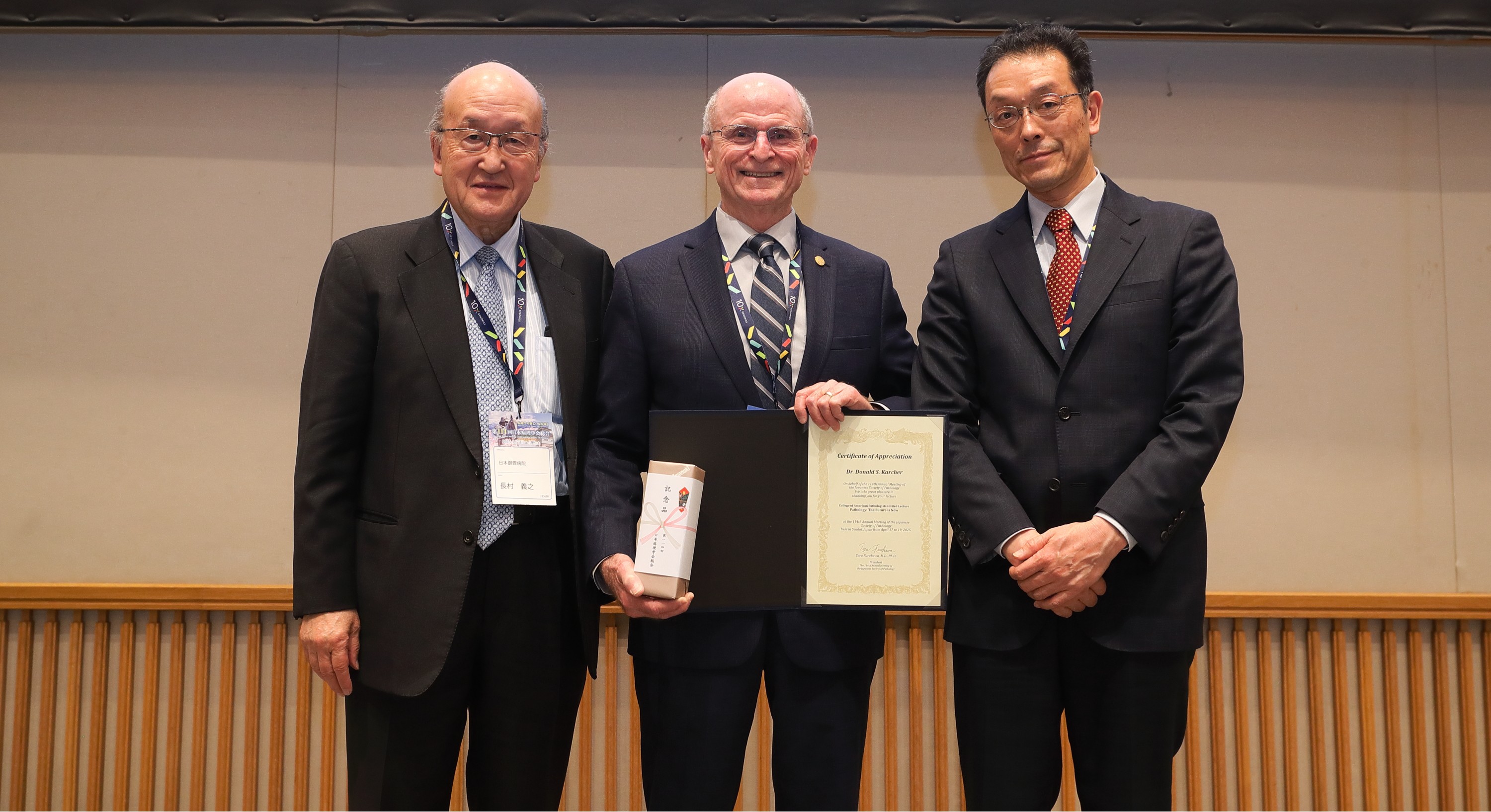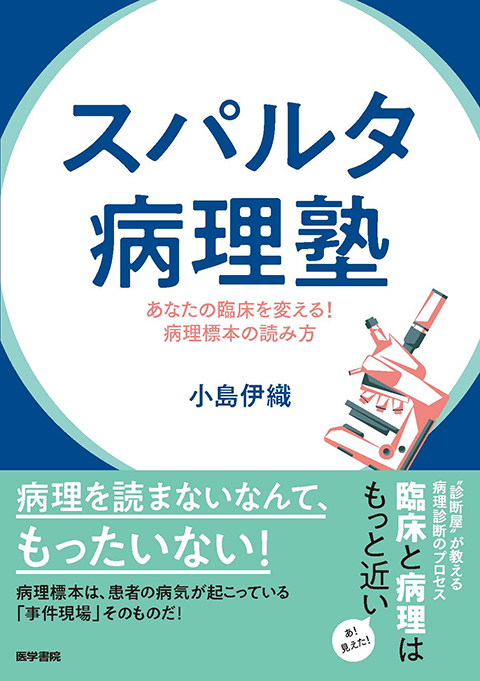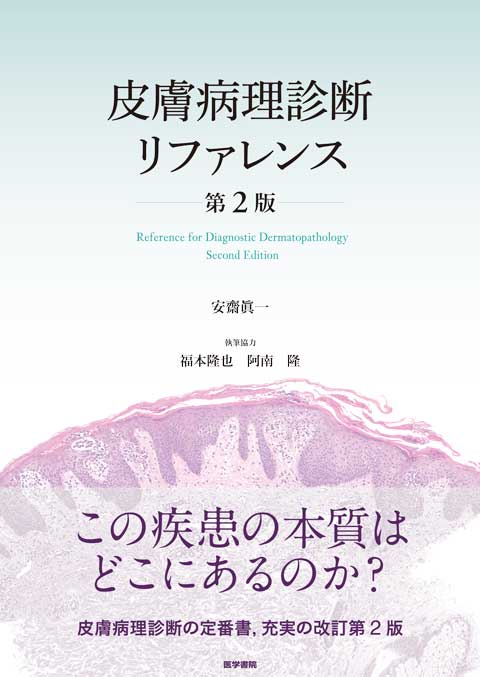- HOME
- 医学界新聞プラス
- 医学界新聞プラス記事一覧
- 2025年
- 医学界新聞プラス 第114回日本病理学会総会開催
医学界新聞プラス
第114回日本病理学会総会開催
取材記事
2025.06.06
【English】
第114回日本病理学会総会(会長=東北大学・古川徹氏)が4月17から19日にかけて,「病理学の新しい扉を開く ――Opening New Doors in Pathology」をテーマに仙台国際センター(仙台市)で開催された。
『医学界新聞プラス』では, Donald Karcher氏による招聘講演「Pathology:The Future is Now」(座長=日本鋼管病院・長村義之氏)の模様を報告する。Karcher氏は米ジョージ・ワシントン大の病理学教授であり,全世界で約2万人の会員を擁する米国病理医協会(College of American Pathologists:CAP)の会長を務めている。
ゲノム医療の発展に伴い,臨床検査における精度と信頼性は国際的に一層重要視されており,日本でもCAPによる臨床検査室認定(CAP認定)を取得する医療機関が増加している。今回の来日に際し,Karcher氏はCAP認定を取得している青森県立中央病院を視察したほか,厚生労働省を訪問し,医療水準の向上に関する意見交換を行った。日本の地域医療や医療技術の現状に理解を深めた上で,本講演に臨んだ。
Karcher氏は自身の講演を「デジタル時代における病理医と臨床検査技師の世界的不足」と題し,CAPのリサーチデータを基に,①病理医・臨床検査技師の需給における国際的な現状と地域格差,②デジタル・AI技術の進歩が病理診断にもたらした影響,③今後の病理医に求められるスキルに焦点を当て,病理学の未来を担う来場者たちに向けた発表を行った。
① 病理医・臨床検査技師の需給における国際的な現状と地域格差
Karcher氏はまず,病理医の需給に関する国際的な状況を概説した(図)1)。WHOの推定によると,世界の医師総数約1320万人のうち,病理医はおよそ0.8%にとどまる。Karcher氏は人口100万人当たりの病理医数は世界平均で14人であるのに対し,米国は65人,日本は21人と上回っている一方,アフリカでは3人未満と極端に少なく,医療アクセスにおける深刻な地域格差が存在していると指摘した。また米国や日本においても,病理診断需要は増加しているにもかかわらず病理医の数はそれに見合うペースで増えておらず,今後は高齢化の影響も重なり,これらの地域でも供給不足に陥る可能性があると警鐘を鳴らした。
Karcher氏はこうした世界的な病理医不足の対策として,各国政府や教育機関と連携しながら将来の担い手を育成することの重要性を強調した。CAPが医学生に向けて病理学の魅力を発信する啓発活動を継続していることや,研修医の受け入れ枠拡大をめざして医師関連団体が法改正を働きかけている米国の現状についても紹介した。
さらに病理診断を支える重要な医療従事者である臨床検査技師についても,世界的な人員不足が長年にわたり課題であると述べた。特にCOVID-19のパンデミック下では,臨床検査技師の需要が急増した一方で離職・退職者の増加によって問題がさらに深刻化したという。こうした状況を踏まえ,Karcher氏は(1)STEM教育(科学・技術・工学・数学)の早期段階からの充実,(2)臨床検査分野を将来のキャリアとして早期に認識させる教育機会の創出,(3)各国政府による財政的支援の強化などの取り組みが今後一層求められると述べた。
② デジタル技術とAIの進歩が病理診断にもたらした影響
Karcher氏は次に,デジタル技術およびAIの進展が病理診断分野に与えている影響について解説した。COVID-19パンデミックを契機に,病理診断へのデジタル技術の導入が加速し,特にデジタル画像や検査データを病理医がリモート環境で確認・診断する「遠隔サインアウト」の利用が広がっている。Karcher氏は米国における現状として,遠隔サインアウトの普及により,小規模および地方の検査室を含むあらゆる検査室において専門医による迅速なサインアウトの実施が可能になり,他施設への画像の送信も容易になってきていると報告した。またAI技術の発展については,特に解剖病理学と臨床検査におけるホールスライドイメージング(WSI)の普及が画像解析AIの開発を加速させている点を強調した上で,デジタルパソロジー促進への投資と病理学分野におけるAIの進歩は言わば「鶏と卵」のような相互関係にあると説明した。病理学領域におけるAIの活用例としては,反復的作業の自動化,臨床的に意味のあるデータやパターンの検出,所見の客観性・一貫性の向上,人間では見落としがちな微細な異常の識別,異なるデータソースからのテキストや画像の生成など,多岐にわたる可能性が挙げられた。
一方でKarcher氏は,こうした技術の進化がもたらす利点を認めながら,懸念点として,病院内の他の臨床医や患者と病理医とのつながりが希薄になることで,病理医の存在感が低下する可能性があることにも言及した。医療における技術と人との共存について,今後も慎重に方策を探っていく必要があると述べた。
③ 今後の病理医に求められるスキル
「AIが病理医に取って代わることはない。しかし,AIを使いこなす病理医がそうでない病理医に取って代わるだろう。」 2)
これは,Karcher氏が講演の中で引用した,米スタンフォード大の放射線科医であるCurtis Langlotz 氏の言葉だ。
Karcher氏はデジタルおよびAI技術の急速な発展に伴い,病理医・臨床検査技師に求められるスキルも変化していることを強調した。病理医には従来の臓器横断的な医療知識に加え,血液,消化器,皮膚など特定分野への専門性がより強く求められるようになった。さらに,デジタル画像を診断に効率的に活用する力,AIを診断プロセスに統合的に組み込む能力が重要になってきていると分析した。一方,臨床検査技師にはWSIシステムの検証支援,顕微鏡スライドのスキャンおよびデジタル化,デジタル技術に適応したワークフローの管理,さらにAIシステムのモニタリング支援といった,新たな業務スキルが求められてきているという。
Karcher氏はこうした変化に対応するため,CAPでもWSI検証のためのガイドライン策定やAI関連委員会の設立などを通じて医療現場のキャッチアップをサポートしている実情を紹介しつつ,
「AIが病理医に取って代わることはない。ただし,AIを “効果的に使う方法を知っている” 病理医が,そうでない病理医に取って代わることになるだろう。」
と先の引用を踏まえた自身のメッセージを来場者に伝えた。
*
最後にKarcher氏は,デジタル技術とAIには診断の質と効率を飛躍的に高める可能性があり,病理医をはじめとする医療人材不足の解決においても重要な鍵を握ると強調した。その上で,「病理医について “Pathologists are Doctor’s Doctor”(病理医は医師のための医師)と表現されることがある。しかし私は “Pathologists are Patient’s Doctor"(病理医は患者のための医師)であると信じている。皆さんも自らが患者のための医療者であることを常に心に留め,今後も,医療の発展と自己の研鑽に力を尽くしてほしい」との思いを述べ,講演を締めくくった。
参考文献・URL
1)Andrey Bychkov, Michael Schubert.Constant Demand, Patchy Supply.2023.
2)Nature.2019[PMID: 31853073]
The 114th Annual Meeting of the Japanese Society of Pathology
The 114th Annual Meeting of the Japanese Society of Pathology (Congress President: Dr. Toru Furukawa, Tohoku University) was held from April 17th to 19th at the Sendai International Center (Sendai City) under the theme "Opening New Doors in Pathology."
Igaku-kai Shinbun Plus reports on the invited lecture by Dr. Donald Karcher titled "Pathology: The Future is Now" (Chairperson: Dr. Yoshiyuki Osamura, Nippon Kokan Hospital). Dr. Karcher is a professor of pathology at George Washington University in the United States and serves as the president of the College of American Pathologists (CAP), which has approximately 20,000 members worldwide.
With the advancement of genomic medicine, the precision and reliability of clinical laboratory testing are becoming increasingly important internationally. In Japan, a growing number of medical institutions are obtaining CAP accreditation for their clinical laboratories. During his visit to Japan, Dr. Karcher visited Aomori Prefectural Central Hospital, which has CAP accreditation, and also visited the Ministry of Health, Labour and Welfare to exchange opinions on improving medical standards. He delivered this lecture after deepening his understanding of the current state of community healthcare and medical technology in Japan.
Dr. Karcher titled his lecture "The Global Shortage of Pathologists and Medical Laboratory Scientists in the Digital Age." Based on CAP research data, he focused on: ① the international status and regional disparities in the supply and demand of pathologists and medical laboratory scientists, ② the impact of advancements in digital and AI technology on pathological diagnosis, and ③ the skills required of future pathologists. He presented these findings to the audience, who will shape the future of pathology.
① International Status and Regional Disparities in the Supply and Demand of Pathologists and Medical Laboratory Scientists
First, Dr. Karcher outlined the international situation regarding the supply and demand of pathologists (Figure)1). According to WHO estimates, pathologists account for only about 0.8% of the approximately 13.2 million physicians worldwide. Dr. Karcher pointed out that while the global average number of pathologists per million population is 14, the United States (65) and Japan (21) exceed this average. In contrast, Africa has extremely few, less than 3, indicating serious regional disparities in medical access. He also warned that even in the United States and Japan, the number of pathologists is not increasing at a pace commensurate with the growing demand for pathological diagnosis. Furthermore, the impact of an aging population will exacerbate this issue, potentially leading to supply shortages in these regions as well.
As a countermeasure to this global shortage of pathologists, Dr. Karcher emphasized the importance of nurturing future professionals in collaboration with governments and educational institutions. He introduced CAP's ongoing awareness campaigns to promote the appeal of pathology to medical students and mentioned the current situation in the United States, where physician-related organizations are lobbying for legal revisions to expand residency training slots.
Furthermore, he stated that a global shortage of medical laboratory scientists, who are crucial healthcare professionals supporting pathological diagnosis, has been a long-standing issue. This problem was further exacerbated during the COVID-19 pandemic due to a surge in demand for medical laboratory scientists coupled with an increase in resignations and retirements. In light of this situation, Dr. Karcher stated that initiatives such as (1) strengthening STEM education (science, technology, engineering, and mathematics) from an early stage, (2) creating educational opportunities to encourage early recognition of the clinical laboratory field as a future career path, and (3) enhancing financial support from national governments will be increasingly necessary in the future.
② The Impact of Advancements in Digital Technology and AI on Pathological Diagnosis
Next, Dr. Karcher explained the impact of advancements in digital technology and AI on the field of pathological diagnosis. The COVID-19 pandemic accelerated the introduction of digital technology into pathological diagnosis, particularly the use of "remote sign-out," where pathologists review and diagnose digital images and test data remotely. Dr. Karcher reported that in the United States, the popularization of remote sign-out has enabled rapid sign-out by specialists in all laboratories, including small and rural ones, and has facilitated the easy transmission of images to other facilities. Regarding the development of AI technology, he emphasized that the popularization of whole-slide imaging (WSI) in anatomic pathology and clinical laboratory testing is accelerating the development of image analysis AI. He explained that investment in promoting digital pathology and the progress of AI in the field of pathology have a "chicken and egg" relationship. Examples of AI applications in pathology include automation of repetitive tasks, detection of clinically significant data and patterns, improvement of objectivity and consistency of findings, identification of minute abnormalities often overlooked by humans, and generation of text and images from different data sources, offering a wide range of possibilities.
On the other hand, while acknowledging the benefits brought about by these technological advancements, Dr. Karcher also mentioned concerns that the weakening connection between pathologists and other clinicians or patients within the hospital could diminish the presence of pathologists. He stated that it is necessary to continue carefully exploring ways for technology and humans to coexist in healthcare.
③ Skills Required of Future Pathologists
“AI will not replace pathologists. However, pathologists who use AI will replace those who do not." 2)
This is a quote from Dr. Curtis Langlotz, a radiologist at Stanford University, which Dr. Karcher cited in his lecture.
Dr. Karcher emphasized that the skills required of pathologists and medical laboratory scientists are also changing with the rapid development of digital and AI technologies. In addition to conventional cross-organ medical knowledge, pathologists are now increasingly required to have expertise in specific fields such as hematology, gastroenterology, and dermatology. Furthermore, he analyzed that the ability to efficiently utilize digital images for diagnosis and to integrally incorporate AI into the diagnostic process has become important. On the other hand, medical laboratory scientists are now required to possess new job skills such as supporting WSI system validation, scanning and digitizing microscope slides, managing workflows adapted to digital technology, and supporting AI system monitoring. Dr. Karcher introduced CAP's efforts to support the medical field in catching up with these changes, such as developing guidelines for WSI validation and establishing AI-related committees.
He then conveyed his own message to the audience, building on the previous quote:
“AI will not replace pathologists. However, pathologists who know how to use AI effectively will replace those who do not."
*
Finally, Dr. Karcher emphasized that digital technology and AI have the potential to dramatically improve the quality and efficiency of diagnosis and hold an important key to resolving the shortage of medical personnel, including pathologists. He concluded his lecture by sharing his thoughts: “Pathologists are sometimes described as ‘Doctor's Doctor.’ However, I believe that ‘Pathologists are Patient's Doctor.’ I hope that all of you will always keep in mind that you are healthcare providers for patients and continue to strive for the advancement of medicine and your own self-improvement."

Reference・URL
1)Andrey Bychkov, Michael Schubert.Constant Demand, Patchy Supply.2023.
2)Nature.2019[PMID: 31853073]
タグキーワード
いま話題の記事
-
対談・座談会 2025.12.09
-
医学界新聞プラス
[第1回]心エコーレポートの見方をざっくり教えてください
『循環器病棟の業務が全然わからないので、うし先生に聞いてみた。』より連載 2024.04.26
-
医学界新聞プラス
[第2回]アセトアミノフェン経口製剤(カロナールⓇ)は 空腹時に服薬することが可能か?
『医薬品情報のひきだし』より連載 2022.08.05
-
対談・座談会 2025.12.09
-
厳しさや大量の課題は本当に必要か?
教育現場の「当たり前」を問い直す対談・座談会 2025.12.09
最新の記事
-
厳しさや大量の課題は本当に必要か?
教育現場の「当たり前」を問い直す対談・座談会 2025.12.09
-
対談・座談会 2025.12.09
-
対談・座談会 2025.12.09
-
インタビュー 2025.12.09
-
ロボット,AIとARが拓く看護・在宅ケア
安全はテクノロジーに,安心は人に寄稿 2025.12.09
開く
医学書院IDの登録設定により、
更新通知をメールで受け取れます。





![組織病理カラーアトラス[Web付録付] 第3版](https://www.igaku-shoin.co.jp/application/files/8816/1881/2522/108972.jpg)